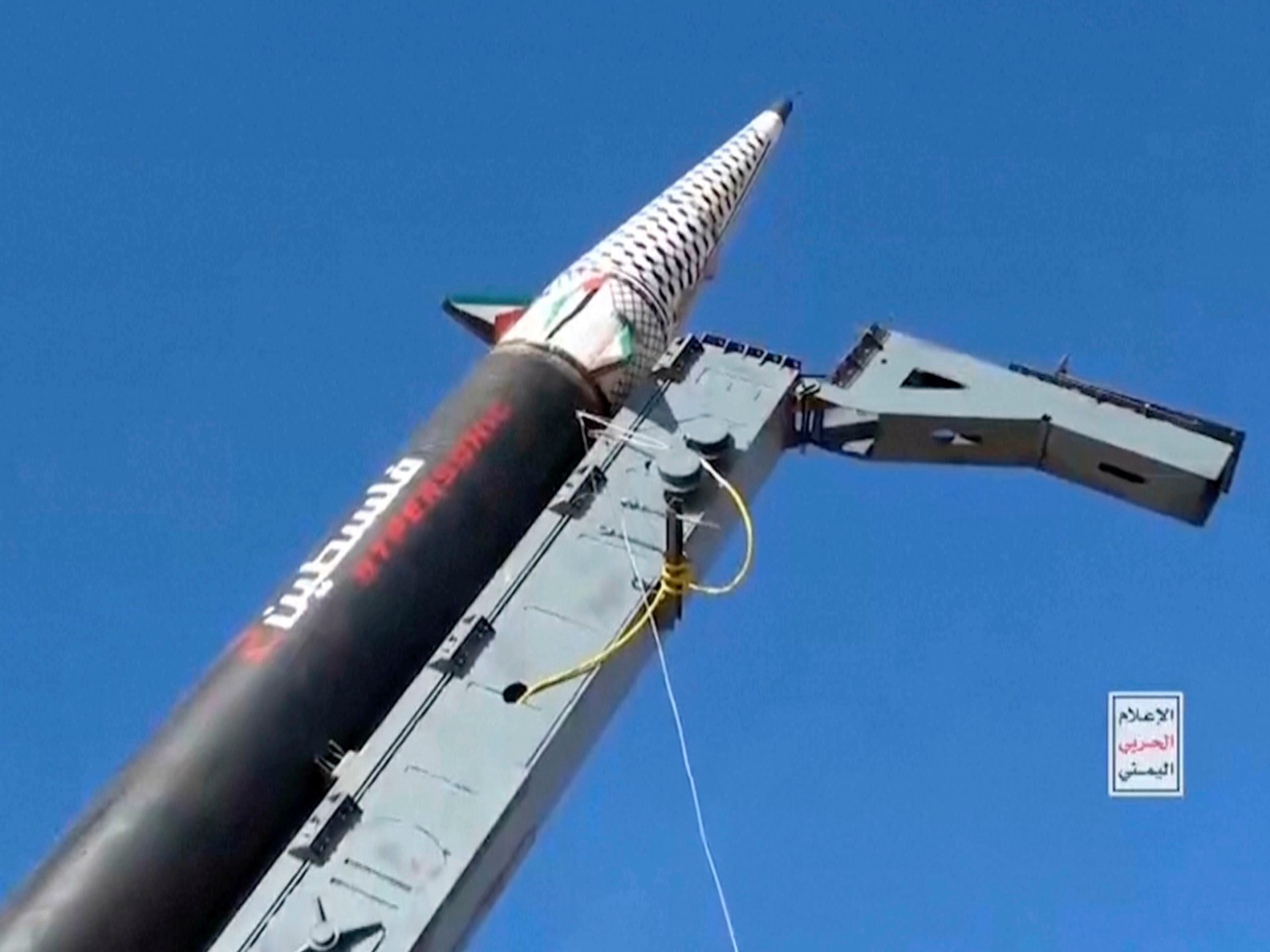On Sunday, Yemen’s Ansar Allah, commonly known as the Houthis, launched what they said was a hypersonic missile at central Israel.
It caused fires, triggered air raid sirens, and sent residents running for shelter in the area around Ben Gurion Airport.
The Houthis said Israeli defence systems could not take down their missile.
An Israeli official said nine people suffered minor injuries.
The Houthis have been attacking ships they see as linked to Israel – in the Red Sea, the Gulf of Aden and the Bab al-Mandeb Strait – since November, in proclaimed solidarity with Palestinians and against Israel’s continuing war on Gaza.
So, what was the Houthi missile?
The Houthis claimed they launched a hypersonic ballistic missile that flew 2,000km (1,240 miles) from Yemen to central Israel in 11 minutes.
Israel said the missile was not hypersonic, adding that it “did not manoeuvre in flight”, according to The Times of Israel.
“Unless Russia or North Korea passed this technology to the Houthis … it’s more likely that the missile in question is supersonic,” Mohammed Al-Basha, senior Middle East analyst for the Navanti Group, told Al Jazeera.
“Supersonic missiles rely on conventional rocket motors and control systems, whereas hypersonic missiles demand advanced materials capable of withstanding extreme thermal, mechanical and acoustic stress at high speeds.
“Verification would depend on confirmation [of] tracking the missile. If it exceeded Mach 5, that would indicate the Houthis have acquired hypersonic technology,” Al-Basha said.
He added: “The design of the [Houthis’] Palestine missile series closely mirrors Iran’s medium-range ballistic missiles. It could be a hybrid, with front fins and the warhead resembling the Fateh-110, while the rear fins are similar to the Kheibar Shekan.
“The Houthis have added distinct markings, including a black-and-white chequered keffiyeh pattern, and the flag and map of Palestine.”
Was the missile intercepted?
Nasreddin Amer, the vice chairman of the Houthi media authority, said in a post on X on Sunday that “20 missiles failed to intercept” the missile.
Israel claims the Houthi missile was damaged, but not destroyed, by an Israeli interceptor missile.
Shrapnel fell from the Houthi missile and interceptors into an open area close to Kfar Daniel – just over 15km (nine miles) from Ben Gurion – and started a fire.
What was the reaction in Israel?
The initial attack sent people running, but airport authorities said operations resumed shortly after.
Israeli Prime Minister Benjamin Netanyahu said the Houthis would pay a “heavy price” for an attack he said was part of a “multifront battle against Iran’s axis of evil that strives to destroy us”.
“Whoever needs a reminder of that is invited to visit Hodeidah port,” he said, speaking of a July attack by Israel that killed three people and wounded at least 80 others.
Magen David Adom, Israel’s national emergency services, said nine people had suffered minor injuries.
“Israel’s modus operandi in the region is predictable … it may respond with long-range air strikes targeting key locations such as the Ras Issa Oil Terminal, as-Salif, and Hodeidah ports,” Al-Basha said.
“Alternatively, Israel might employ cyberattacks or covert operations to hit missile launch sites in Yemen, disrupt Iranian supply routes, or assassinate Houthi leadership, mirroring its previous actions in Gaza, Iran, Iraq, Lebanon and Syria.
“On the diplomatic front, Israel may intensify its efforts to lobby the US, UK and EU for increased sanctions on the Houthis, potentially pushing for their designation as a foreign terrorist organisation.”
What are the Houthis trying to achieve?
This is the deepest missile strike into Israel by the Houthis.
“From a political and strategic perspective, the fact that the Houthis – who don’t share a border with Israel – are launching attacks from 2,000km away and reaching central Israel suggests advancements in missile and drone technology, with support from Iran,” Al-Basha said.
“This has a psychological impact, exposing potential vulnerabilities in Israel’s Iron Dome, David’s Sling, and Arrow air defence systems.
“Moreover, it elevates the Houthis’ profile as a rising military force in the region,” he said.
The Times of Israel counted more than 220 ballistic missiles, cruise missiles and drones fired by the Houthis at Israel over the past 11 months.
According to the Houthis, the “new hypersonic ballistic missile” travelled 2,040km (1,268 miles) in 11 minutes to target “a military position of the Israeli enemy in the Jaffa area”.
Houthi spokesman Yahya Saree also said Israel should expect more operations as the anniversary of the October 7 start of Israel’s war on Gaza approaches.
The Houthis have also “been telegraphing they would still respond to Israel’s July 20 attack on Hodeidah … and this … allows them to claim to have escalated,” Yemen analyst Nicholas Brumfield told Al Jazeera.
Why is this particular Houthi attack significant?
This latest missile struck deeper than any past attack.
Of those past attacks, few have damaged Israeli territory or hurt people – the drone attack on July 19 was the first to kill an Israeli.
The fact the missile made it as far as it did, despite Israel’s defences, will be a boost to the group’s confidence.
“It also allows them to show off their capabilities and claim a greater regional importance as they in many ways lead the ‘axis of resistance’s’ response to Israel’s attack on Gaza,” Brumfield said.




![Tyson Foods Plant [Photo: Food Manufacturing]](https://southarkansassun.com/wp-content/uploads/2023/08/iStock_1185520857__1_.5e441daa51cca-600x337.jpg)







![Silverado Senior Living Management Inc. [Photo: Los Angeles Times]](https://southarkansassun.com/wp-content/uploads/2023/10/download-6-4-600x337.jpg)

![China's Wuhan Institute of Virology [Photo: Nature]](https://southarkansassun.com/wp-content/uploads/2023/09/d41586-021-01529-3_19239608-600x337.jpg)
















